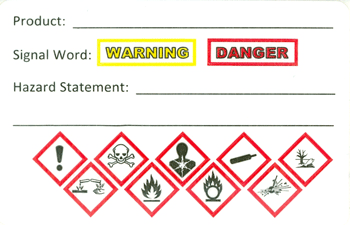March 2017

New Regulations, New Labels
Labeling is an important practice to ensure safety in a laboratory setting. New regulations from OSHA now require hazards and pictograms to be declared on containers. Similarly, the EPA will be requiring hazards to be written on waste containers as well. EHS has made new labels that will comply with these regulations.
Secondary Container Label
This label is necessary if a product is being transferred into another container. If the lab operates under a Chemical Hygiene Plan and the OSHA Laboratory standard, this label needs to be used if:
- The material is not use in the work shift by the individual who made the transfer
- The worker leaves the work area or the container leaves the work area.
This means that containers like solvent wash bottles will need to be labeled with the information in the above label. It is not necessary for samples (though those should be labeled for easy identification). This label, and training on using the label, is currently available through EHS (4-3152).
Hazardous Waste Label
This label is necessary for all mixed hazardous waste as soon as the first drop of waste enters a container. The constituents must be written out and percentages approximated for each. No Hazardous waste label is necessary if the chemical is in its original container. The hazard section of the label should be filled out based on generator knowledge and SDS information for the chemical in the waste container. This label will be made available during Summer 2017.
Steps to a Successful Laboratory Cleanout
- Designate 1 or 2 knowledgeable people to manage the cleanout.
- If radioisotopes used in the lab, contact the radiation safety group (4-7969) for disposal and decommissioning information.
- Find a safe place to store chemicals for an extended period of time. A hood or lab bench where the chemicals can be organized is best.
- Write up the chemicals on a Hazardous Materials Pickup Request form. Keep the chemicals in the order that they are written up. Submit pickup requests in groups of 100 items or less. Ensure items are labeled properly.
- Chemical wastes should have an orange Hazardous Waste Disposal Tag with the contents and percentages written on it. Chemicals should be written out, no abbreviations or chemical formulas. Original containers with a manufacturers label do not need a disposal tag.
- Unknown chemicals should be stored separately. When you submit these, describe the container and its contents as best as possible so it is easily identifiable.
- Cleaning out a freezer? In most cases, those items need to be brought up to room temperature before they can be picked up. Contact EHS (4-0121) for questions.
- Once the pickup request is submitted it can take up to 2 weeks for the request to be picked up.
Campus Safety Contacts

If you see something, say something.
Purdue Police
Phone: (765) 494-8221
Purdue Fire
Phone: (765) 494-6919
Sign up for Emergency Text Messages
Do you want to recognize one of our staff for a job well done? Nominate the staff member(s) for a Bravo Award here!

